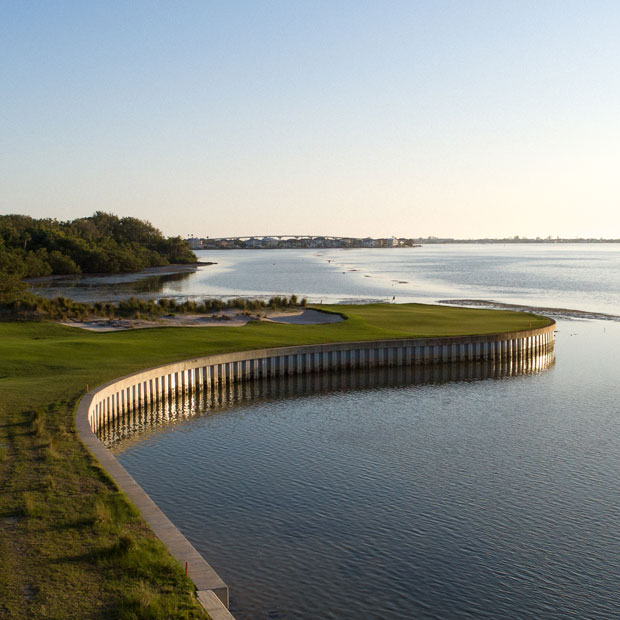A Different Tom Doak at Memorial Park
Excerpts from the Yolk with Doak on the Houston muni


In 2020, the PGA Tour’s Houston Open moved to Memorial Park Golf Course, a municipal course that sees 60,000-plus rounds of golf a year. The course underwent a significant renovation in 2019 courtesy of Tom Doak – his first project to host the PGA Tour – and his player consultant, then-world No. 1 Brooks Koepka.
Across a handful of Yolk with Doak episodes on the Fried Egg Golf Podcast in 2019, the esteemed architect shared his conversations with Koepka about the course, as well as his thoughts on the design and testing professionals while not alienating the amateurs who play the course the other 51 weeks of the year. To help preview this week’s Texas Children’s Houston Open, here are some excerpts from Andy Johnson’s chats with Doak in Episode 13 and Episode 15 of the Yolk with Doak.
Memorial Park’s Intrigue
“It’s a complicated project, but, for me, the attraction is that I’ve always been interested in doing a course for the Tour players, especially now that more people say ‘he’s not the guy to do that.’ ‘That’s not his thing.’ And especially the more people say, ‘It can’t be done. (Professionals) hit it so far now it’s impossible, you just have to build entirely separate courses for them.’ We’re not doing that here. It’s still going to be a municipal course that plays 60,000 rounds the other 51 weeks of the year. … So we have to figure out how are we going to do this and how long do we need to make a golf course to make it interesting for (the professionals).”
Working with Player Consultant Brooks Koepka
“To break the ice, I sent (Koepka) a few questions to think about: What do you like about Tour courses? What do you really not like about them? What do you think you do well that is not rewarded by them? I thought he would think about them and we’d talk about it when we got together. He got back to me the next day in the middle of playing that event in Korea, which he won.
“Memorial Park is already 7,300 yards long. He said he really thought that was probably long enough. He didn’t think that you needed to build much longer courses to test the players. He thought you should do the details different, but it wasn’t about length.
“He’s thought about architecture. He has some definite ideas on what he’d like to see. There wasn’t anything in there that I really disagreed with. . . . He didn’t say anything specifically about green size, but I got the impression from some of the other things he said that he thinks smaller greens or skinnier-angled greens is part of the solution.”
“I can relate to him on a bunch of levels … He’s pretty quiet to be around most of the time, but that doesn’t mean there isn’t stuff going on in his mind. And he’s starting to get more comfortable saying it, and sometimes it rubs people the wrong way and I can really relate to that. That’s me, too. People don’t think you say enough, and then you tell them something they don’t want to hear, and they’re upset about it. He lets it roll off his back pretty easily. He doesn’t get too upset with what anybody else is thinking. He’s one of the most confident people I’ve ever met.
“His input on the golf course features was more about subtle things, like how it’s hard to control a shot off an uneven lie in the rough. That’s harder than being in a bunker. So some undulations in the driving zone out of the edges would really make a difference that, if you’ve got a hook lie in the rough, and there’s some trouble left to the green, okay, now I really got to think about what shot am I trying to hit here, because this could get away from me pretty fast … My courses probably have some of that in them because they’re undulating naturally, but I never really thought about that kind of thing that much.”
Bailing on Bunkers
“One of the things we’re going to talk about really hard in Houston is why have a lot of bunkers at all? Because the penalty value for the good players is almost zero. So why have many?
“When I got together with Brooks Koepka the first time, one of the things I asked him was, ‘Would you care if we didn’t have very many bunkers?’ And he said, ‘No, bunkers, for the most part, we don’t think about them a lot anymore.’ A lot of times it’s easier to be in the bunker than in long grass in the same situation relative to whether you’re 150 yards away from the green or whether you’re right up next to the green . . . . When (players) think about where to aim, they’re not factoring in the greenside bunker at all because they think they can get up and down from it anyway, so why worry about it? Why let that affect where you’re going to play?
“If you did it for all golfers, the strokes gained for a Tour player out of the bunker compared to the average golfer would be tremendous. There’s probably as big a gap or more of a gap there as there is on how far they hit it. So that’s the kind of thing if you’re trying to design something and get the average guy around and make it challenging for a really good player, why put a bunch of bunkers in? They’re beating up the average guy, and the Tour player doesn’t really give a shit if they’re there at all.”
Why So Much Water?
“We have water much more in play on three or four holes than I normally build. One of the other things the city wanted us to do was try to capture some of the drainage going across the site and reuse it for irrigation instead of just letting it go into the river and out, because in a flood situation, that’s bad. They use city water to irrigate the golf course now, so the less city water they have to use to irrigate the golf course, the better.
“There was a pond in between the 16th and 17th holes on the old golf course and there were kind of some trees around it. You could hit into it, but you played the holes without really thinking about the pond being there. It wasn’t in your face at all. It was maybe a three- or four-acre pond. To make it storage for irrigation to capture and store as much water as we can, we expanded it to like nine acres and it is on the 16th hole. The 16th hole is a reachable par 5 but fairly long. It’s not an island green, but you’ve got to hit over a little neck of this pond in front of the green, and the pond continues down the left side. And then there’s a little spur on the right side, too. So there’s really no bailout. I mean, if you’re going for the green in two, you can’t just take one side out of play and hit it into a bunker to be safe. You’ve got to go for the green.
“Then the 17th hole is a like a 390-yard par 4 that we built them a tee at 300 yards too, and we’re thinking at least one of the two days on the weekend, they’ll move the tee up and see if guys want to go for it 290 over the water on the fly with a green that’s built to kind of receive that shot if you aim to the right place.”

Shotlink data from 2023, showing zero attempts made to drive the green at 17; black dots are bogey or worse, blue dots are pars, red dots are birdies.
A Dramatic Finish
“We’ve got a drivable par 4 for the 13th hole. We’ve got a short par 5 for the 14th hole. We’ve got a short par 3 that you can get yourself in some real trouble on 15. We’ve got that par 5 16th that I talked about that those guys are long enough to go for it, but they’re taking their life in their hands if they do. And if you don’t, you just have to hit a very simple layup and look like a wimp.
“The guy who doesn’t go for it is going to get the Chip Beck thing of, ‘You’re such a wimp. You didn’t go for it when you had a chance.’ Even if it’s a bad play for them, clearly a bad play for them, it’s still like ‘You could have reached. You just didn’t want to.’
“Obviously, we don’t care what the winning score is going to be. I mean, we’re giving them a chance to go really low, and we’ve never talked about what the winning score is going to be. It’s just like, let’s make a bunch of exciting holes at the finish where there can be big swings.”
A Different Doak
“People know an architect’s work for either their bunkers or their greens, honestly. And obviously for the Tour, for a Tour event, we have to be a little more cautious and subtle on the greens complexes than we would other places. So I don’t think you’d pick out those greens right away as being mine. I mean, we’ve changed them all from what they were from the old golf course that was there. And, not saying there’s not some tricky things going on in some of them, but you know, it’s a flat site to start with. So you’re not going to have a lot of severe contour in greens. You get severe contour in greens on hilly sites.
“When (Alister MacKenzie) built things on really flat sites, he might jazz up a few greens, but it’s not like they are all the way Augusta’s are. So in Houston, kind of the same. There’s a couple of pretty interesting greens, I don’t think there’s one of them that you just recognize as ‘that looks like something Tom’s done before.’
These conversations have been edited for length.
This piece originally appeared in the Fried Egg Golf newsletter. Subscribe for free and receive golf news and insight every Monday, Wednesday, and Friday.
Leave a comment or start a discussion
Engage in our content with thousands of other Fried Egg Golf Club Members
Engage in our content with thousands of other Fried Egg Golf Members
Get full access to exclusive benefits from Fried Egg Golf
- Member-only content
- Community discussions forums
- Member-only experiences and early access to events











Leave a comment or start a discussion
Lorem ipsum dolor sit amet, consectetur adipiscing elit. Suspendisse varius enim in eros elementum tristique. Duis cursus, mi quis viverra ornare, eros dolor interdum nulla, ut commodo diam libero vitae erat. Aenean faucibus nibh et justo cursus id rutrum lorem imperdiet. Nunc ut sem vitae risus tristique posuere. uis cursus, mi quis viverra ornare, eros dolor interdum nulla, ut commodo diam libero vitae erat. Aenean faucibus nibh et justo cursus id rutrum lorem imperdiet. Nunc ut sem vitae risus tristique posuere.